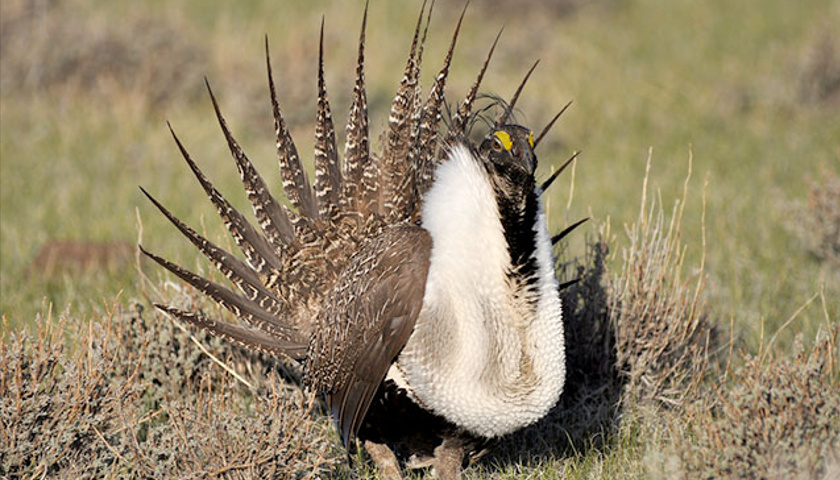By Natalia Castro
For years, a bird has been the most expensive drain on the Midwest’s economy. The greater sage grouse is not listed as an endangered animal under the Endangered Species Act, but this has not prevented the U.S. Fish and Wildlife Service (FWS) from placing significant restrictions on business and lifestyle throughout the Midwest in an attempt to protect this notably flamboyant bird. One of few bright spots in Congress’s recently passed budget was a rider preventing the bird from being listed under the ESA due to its vast protections, but more must be done to ensure an overpopulated bird cannot undermine the economic development of several western states.
Finalized in 2015 through the Obama Administration’s Department of Interior, the sage grouse protection plan was a large scale federal conservation plan to preserve a bird that was not even threatened enough to land on the endangered species list. At the time, Department of Interior Secretary Jewell called the plan “historic,” as it dedicated 5.5 million acres of land across ten states to conservation efforts.
As it became quickly clear, environmentalists were the only ones singing praises to this plan.
University of Idaho economist Neil Rimbey explained to the Capital Post, to meet concern surrounding the sage grouse, land managers place restrictions on ranchers, usually requiring ranchers to delay grazing by a month or remove cattle a month early. Rimbey continues, this is done “with no idea of the economic impact, and they can have a very dramatic impact at the ranch level.”
This economic impact is felt across the western lands, from individual ranches to large oil companies.
A University of Wyoming 2016 report found, “Due to the large surface area occupied by sage-grouse in Wyoming, the management of sage-grouse habitat could potentially have a significant economic impact on the State of Wyoming in terms of reductions in commodity production caused by management actions intended to protect the species’ habitat… For oil and gas development and wind development the direct economic impact estimates represents regional expenditures to develop these resources. The annual direct economic impact for commodity production from sage-grouse habitat is estimated to be $18.4 billion. This represents 22 percent of the total economic output for the entire Wyoming economy”.
An $18.4 billion price tag is a lot to pay for a bird that is not endangered, but when looking at comparative maps of the area, it becomes clear environmentalist are not simply trying to save an already abundant bird, they are also trying to further an anti-oil agenda.
The areas listed as sage grouse conservation sites cover some of the most shale oil-rich lands in the western states. By placing protections on this bird, the Obama-era Interior Department threatened to halt one of the most promising new areas of domestic energy production.
The University of Wyoming report continued, since sage grouse protections were implemented, they have cost the state of Wyoming nearly 80,000 jobs in the oil and gas well drilling and production industries.
While much of the recent Congressional omnibus bill has sparked controversy, one matter that can be celebrated was the prevention of the sage grouse from receiving further environmental protections under the ESA.
Section 120 of the Consolidated Appropriations Act of 2018 explains, “None of the funds made available by this or any other Act may be used by the Secretary of the Interior to write or issue pursuant to section 4 of the Endangered Species Act of 1973 (16 U.S.C. 1533) a proposed rule for greater sage-grouse (Centrocercus urophasianus); a proposed rule for the Columbia basin distinct population segment of greater sage-grouse.”
While this prevents the ESA from being weaponized by environmentalists to halt energy production in this fiscal year, it does not open those areas back up for business and prevent agency abuse in the future.
In a letter to House Appropriations Committee Chairman Ken Calvert, 11 Congressional members led by U.S. Rep. Paul Gosar (R-Ariz.) urged Calvert to include a second rider. This rider, outlined in the letter, would end the current conservation plan in place and prevent the bird from being labeled in the ESA for the next five years.
The letter explains, “If the Executive branch makes progress reducing the overreach of the past Administration and its land use plans, there will be a renewed frenzy from radical advocacy groups to seek an ESA listing in order to prohibit responsible mining, energy, grazing and development projects. Congress must act to ensure the Sage Grouse cannot remain an arbitrary regulatory cudgel in the years ahead and provide federal agencies the protections they need to unwind previous overreach.”
While the omnibus bill provided a small step in removing environmentalist overreach, more must be done. Congress cannot simply prevent the sage grouse from being listed in the ESA now, they must undo the land management policies of the Obama Administration to allow industry to open once again. This bird is not endangered, and so environmentalists cannot be allowed to create policy based on destruction, Congress must continue working to ensure all of Obama’s land management overreach is repealed.
– – –
Natalia Castro is a contributing editor at Americans for Limited Government.
Correction: Section 120 of the Consolidated Appropriations Act of 2018 does not remove the Obama era sage grouse conservation plan, it simply prevents the sage grouse from being listed as an endangered species under the ESA. This piece has been updated to reflect this correction.






